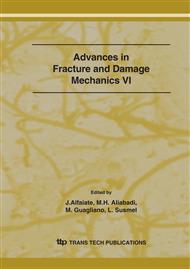p.21
p.25
p.29
p.33
p.37
p.41
p.45
p.49
p.53
Effect of Triaxiality on Damage Parameters in Adhesive
Abstract:
Adhesive in joints will have complex stress state rather than bulk adhesives. This will lead to the assumption behind bulk adhesive that triaxiality function (Rv) is equal to one (uni-axial stress state) is not valid anymore. In this paper, new procedure to find damage parameters α and β for single-lap joints has been developed based on global damage of adhesive joints. With this procedure, damage parameters α and β have been found. Validating the procedure by calculating the number of cycles to failure (Nf) has been performed successfully. The accuracy of the damage evolution equation is less than 2 %.
Info:
Periodical:
Pages:
37-40
Citation:
Online since:
September 2007
Authors:
Price:
Сopyright:
© 2007 Trans Tech Publications Ltd. All Rights Reserved
Share:
Citation:


